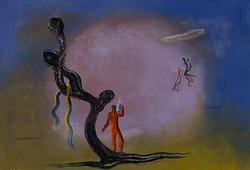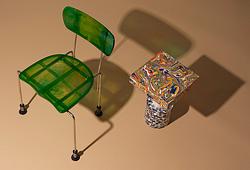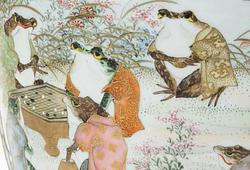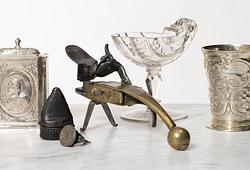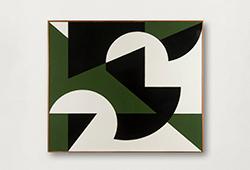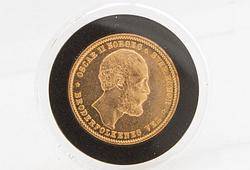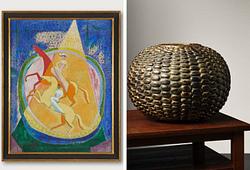Öyvind Fahlström
"il boschetto dei prossimi lieti eventi"
Verso with title and date by the artist. Executed in Rome, Nov-Dec 1958 (no. 58/29 in the artist's own list). Canvas, Vinaril, lacquer, markal, deco, cado, indian ink, 57 x 68 cm.
Alkuperä - Provenienssi
Hans von Heland, owner of Galleri Heland, Stockholm, acquired directly from the artist.
Näyttelyt
Galerie Daniel Cordier, Paris, "Öyvind Fahlström", February - March 1959, cat. no. 8.
Galerie Blanche, Stockholm, "Öyvind Fahlström", 1959, cat. no. 10.
Umeå hantverkshus, "Öyvind Fahlström, Carl Fredrik Reuterswärd, Anders Österlin", 1960, cat. no. 2.
The American Federation of Arts in cooperation with Moderna Museet in Stockholm, "12 Swedish Painters", traveling exhibition no. 62-44, USA, 1962 - 1964, no. 17. Exhibited as follows:
1962; 7- 22 September, AFA Gallery, New York, N.Y. 3 – 24 October G.T. Hunter Gallery, Chattanooga, Tennessee. 5 – 20 November, University of South Florida, Tampa, Florida. 10 – 31 December, Milwaukee Art Center, Milwaukee, Wisconsin.
1963; 14 January – 4 February, Utah Museum of Fine Arts, Salt Lake City, Utah. 25 March– 15 April, Mansfield Fine Arts Guild, Mansfield, Ohio. 29 April – 20 May, Allen Memorial Art Museum, Oberlin, Ohio. 3 - 26 June, Miami Beach Art Center, Miami Beach, Florida. 8 July – 8 August, Dewaters Art Center, Flint, Michigan. 22 August – 22 September, San Francisco State College, San Francisco, California. 6 - 27 October, The American Swedish Institute, Minneapolis, Minnesota. 10 November – 1 December, Hackley Art Gallery, Muskegon, Michigan. 15 December – 5 January, Wayne State University, Detroit, Michigan.
1964; 23 February - 15 March, Southern Illinois University, Carbondale, Illinois. 29 March - 19 April, Howard University, Washington D.C. 3 - 24 May, Gibbs Art Gallery, Charleston, South Carolina.
Galerie Bel' Art, Stockholm, "Öyvind Fahlström: Works 1950 – 1976", 8 March – 12 April, 2003, illustrated in the catalogue as no. 2.
Mjellby Konstmuseum, "Öyvind Fahlström: Med världen som spelplan", 3 June – 16 September 2007.
Kirjallisuus
Utställningskatalog "Twelve Swedish Painters", New York 1962-1964, cat no. 18, illustrated.
Sven-Harrys Konstmuseum, ”Party for Öyvind”, 2021, The American catalogue spread with the auctions work illustrated on p. 264.
Sophie Allgård, ed., "Öyvind Fahlström, Med världen som spelplan", 2007, illustrated in color p. 40.
Muut tiedot
- Öyvind Fahlström, il boschetto dei prossimi lieti eventi. Bo Nilsson composed a string quartet with the same title as the painting (Dungen för de stundande lyckliga tilldragelserna) [The orchard for the approaching happy events], which was performed at the Venice Biennale on the 12th of June 1962. __________________________________________________________________________________________
Bukowskis are delighted to be able to present a central and important work by the still highly relevant multimedia artist Öyvind Fahlström – one of the most important 20th century Swedish artists. Fahlström’s significance can be clearly seen in the ongoing exhibition at Sven-Harrys konstmuseum in Stockholm, entitled Party for Öyvind. Through the arrangement of the exhibition Fahlström’s wide circle of contacts with the leading international artists of his time, such as his good friends Roberto Matta, Robert Rauschenberg and Jasper Johns, is revealed. The present painting was executed in Rome in 1958 and was selected, together with three other pieces, to be included in the touring exhibition Twelve Swedish Painters. Out of the three it was this Fahlström painting that was chosen to be illustrated in the catalogue, and it was immediately sold to the owner of Galleri Heland, Hans Heland.
Fahlström’s work from the late fifties, and up until he moved to New York in 1961, is characterised by the way each individual piece is executed in a completely different style, yet at the same time are clearly recognisable as being by him. His paintings from this period are still considered current today. The confidence in the drawing combined with his sense for colour gives Fahlström’s work an expressive power that is rather unique. Of the paintings done during this period, the piece in the auction is one of the most beautiful and has an entirely unique exhibition history.
il boschetto dei prossimi lieti eventi /Lunden för de följande glada händelserna [The orchard for the approaching happy events]
According to Öyvind Fahlström’s own notes il boschetto dei prossimi lieti eventi was executed in Rome, between November and December 1958. The painting is typical of the artist’s late fifties period, in both colour and material. Fahlström had found his artistic formula with the eleven metre long piece Opera (1952-53). Now he was constructing his first form language with symbols that would come to recur and be modulated, and which, according to Fahlström himself, “[marked] the end of the years of ‘Spontanism’, it is currently about blending spontaneity with the development of various systematic procedures.”
On the international contemporary art scene Fahlström was close to the ‘Spontanists’ (‘Spontanism’ being the overarching term used in the Nordic countries for styles encompassing Art Informel and abstract expressionism), but he wanted to transform traditional approaches and redefine concepts like the figurative and the non-figurative. In an article about Fransisco Nieva’s images he wrote: “We encounter an effective and relationship-developing painting practice of signs... We are faced with a practice that is so explicit in its form and so bursting with new substances that the question of non-figuration or not becomes as meaningful as asking whether a line has one or two sides”. Here Fahlström is spontaneously describing what he himself wanted to achieve in his painting.
The challenge that Fahlström now came up against was to create a structure, a rich network of relations, in order to be able to get closer to a dimension of real time – to movement, one which already existed within other art forms such as film, theatre and music.
In the choice between the figurative and the non-figurative Fahlström chose his own direction and his own term: ‘signifiguration’. He wrote a ten-page manifesto about this new concept, which was about visualising significations (Fahlström was, as well as everything else he did, a Swedish master of the manifesto). Even though he abandoned this direction during the 1960s, some of his form elements continued to live on through the art he created in New York.
In the painting il boschetto... we notice a number of Fahlström’s form-symbols in transformation, elements of form that are reprocessed in all his paintings from this period. A sense of recognition was important to Fahlström, and that the characters (the forms) recurred.
How can one read his images? Even in his canvases with a more standard format Fahlström ignites different periods of time and different courses of action. “The painting cannot be understood as a whole with just one look. It has to be grasped as a series of situations and events, free, some intervening in others, some detached, some encapsulated into larger ones.” Nothing simply ‘is’, everything is ‘in progress’. Fahlström had grandiose intentions of trying to create a “structurally conscious way of looking” in his audience; this was part of the project of producing ‘signifigurative’ art.
In the painting il boschetto... we see lightning, zig-zag shapes, clouds, wire baskets, uniformly dashed sections, coils, waves and outflows. Intricate events and the confrontation between spontaneous initiatives, and the more stable recognisability of the symbols, make it into a dynamic composition. The distance of the viewer to the painting was also an important variable for the artist.
Furthermore, one could dedicate a whole chapter to the titles that Fahlström gave his work. They do not intend to give the viewer a way in, an understanding of something depicted. It would be a mistake to imagine that we will understand Öyvind Fahlström’s art through the titles of his work. It is the poet Fahlström, with five rejected collections of poetry in his drawer, who has invented them, and who often invents new words.
But what kind of ‘orchard’ is it that Fahlström refers to in the title? Perhaps it is us the viewer that he alludes to, and what we might experience faced with the painting, in front of this orchard of approaching happy events. Perhaps in order to ascertain whether we have developed a structurally conscious way of looking?
Teddy Hultberg, author, Fahlström researcher.
October 2021.




